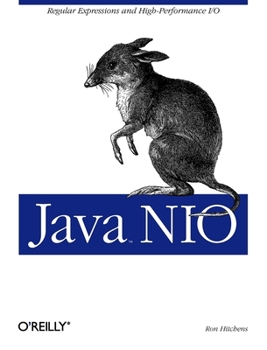Java NIO: Regular Expressions and High-Performance I/O
Select Format
Select Condition 
Book Overview
Many serious Java programmers, especially enterprise Java programmers, consider the new I/O API--called NIO for New Input/Output--the most important feature in the 1.4 version of the Java 2 Standard Edition. The NIO package includes many things that have been missing from previous editions of Java that are critical to writing high-performance, large-scale applications: improvements in the areas of buffer management, scalable network and file I/O,...
Format:Paperback
Language:English
ISBN:0596002882
ISBN13:9780596002886
Release Date:August 2002
Publisher:O'Reilly Media
Length:302 Pages
Weight:1.10 lbs.
Dimensions:0.7" x 7.0" x 9.2"
Customer Reviews
5 ratings
A very good summary and explanation of the New I/O in Java
Published by Thriftbooks.com User , 21 years ago
At only six chapters and 282 pages (including the index) one might think "Java NIO" (short for "New I/O") is little more than a cursory examination of the NIO packages introduced in J2SE 1.4 as a response to the Java Specification Request (JSR) #51. Yet, despite its relatively compact size, Mr. Hichens has done a very good job of introducing and explaining the many aspects of this New I/O. The book even includes parts of JSR 51 that are only tangentially related to I/O, such as the new regular expression processing found in java.util.regex and the new pluggable character set mappings. Chapter 1 is a primer on general I/O concepts and mechanisms and provides a useful foundation for the following information. Beginning with the basics as a foundation is a strategy that Mr. Hichens uses in each of the subjects in the following chapters. It's an important first step, often omitted in books more interested in prose than instruction. Chapter 2 is a thorough explanation of the various Buffer classes. As the means for data accumulation and manipulation, Buffers are a natural first step in explaining the NIO package. It begins with a fairly detailed basic description followed with sections labeled: Creating, Accessing, Filling, Flipping, Draining, Compacting, Marking, Comparing, Bulk Moves, Duplicating, etc. Each section provides simple yet useful examples of the various operations along with some helpful hints and warnings of potential pitfalls. Chapter 3 adds about all you'd want to know about the channels used to convey the data into and out of buffer. As the book explains, Channels "are not an extension or enhancement, but a new, first-class Java I/O paradigm. ... A Channel is a conduit that transports data efficiently between byte buffers and the entity on the other end of the channel (usually a file or socket)." In the ensuing sections: Scatter/Gather, File Channels, Memory-Mapped Files, Socket Channels, Pipes and The Channel Utility Classes, the use of channels within the NIO paradigm are extensively explained. Chapter 4 covers Selectors. Selectors add another completely new ability to Java 1.4. With selectors Java now has a much more sophisticated and integrated ability to do asynchronous and multiplexed I/O. This is obviously very important to anyone dealing with real-time and/or high-demand I/O and it is one of the main reasons for JSR 51. The book does a very good job of explaining the concept and use of Selectors in chapter sections entitled: The Selection Process, Stopping the Selection Process, Managing Selection Keys, Concurrency, Asynchronous Closability and Selection Scaling. Chapter 5 introduces Regular Expressions and explains the use of the new java.util.regex package. Regular expression processing was part of the JSR 51 and thus part of this book. While not strictly I/O related, as anyone familiar with Perl can attest, regular expression processing is very useful when it comes to manipulating any textual data use
A SOUND KNOWLEDGE-SHARING TOOL
Published by Thriftbooks.com User , 21 years ago
What Ron Hitchens did with this book is complete knowledge-sharing. "Java NIO" is just over three-hundred pages, yet, it is big enough to supply developers all the important tuition they need in order to improve their perfomances. This book clearly outlined the best ways of exploiting the I/O capabilities of the newly introduced Java 1.4 version.It also analyzed the NIO APIs in the most comprehensive way. The interest which the contents of this book arouse makes it an important text for developers and enthusiasts alike. Very few complaints will ever go against it. The only one I have is that it may not be too friendly with beginners.
Concise and complete.
Published by Thriftbooks.com User , 21 years ago
A good book overall. Java NIO is a pretty formidable subject. The author does a decent job with this material. The details are concise and complete.
A great read!
Published by Thriftbooks.com User , 21 years ago
Every once in a while, a truly outstanding book comes along, that is a must-read for everyone in a given field. This is such a book. Comprehensive yet concise, clear and engagingly written, this book belongs not just on the bookshelf, but in the hands, of EVERY Java programmer. Buy it, read it, and enjoy it.
High Performance Java I/O Information Not Found Elsewhere
Published by Thriftbooks.com User , 21 years ago
This is an excellent book providing information on the Java NIO and Java I/O in general that you can't find elsewhere. I know, I searched all over the web looking for information and more importantly examples on Java NIO and the best resource I found was this book. It answered all of my questions, gave me concrete examples, and showed how Java I/O fits into the larger model of operating system I/O. If you are developing I/O intensive applications you can't afford to be without this book. And if you aren't, read it anyway and you will improve the speed of your programs tenfold.




